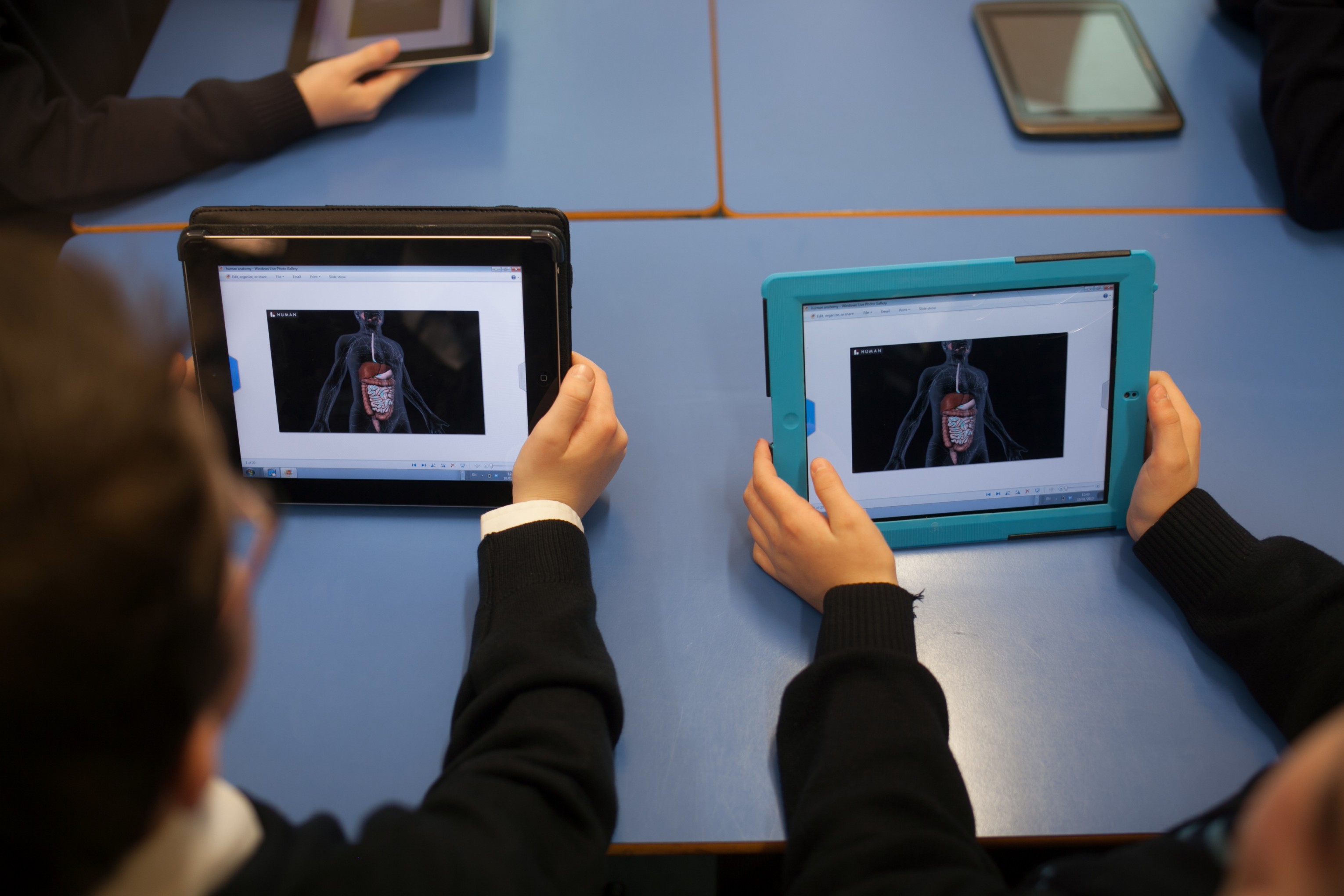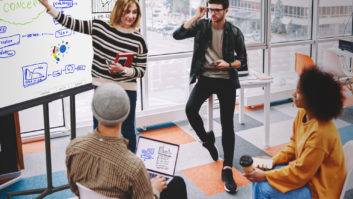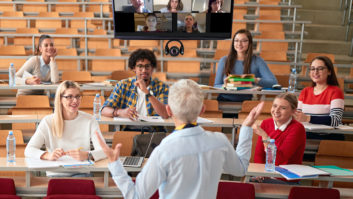
In the first part of this feature we looked at how the market for the latest AV technology within schools has grown, which has seen the market shift away from previously widespread devices such as interactive whiteboards for newer technologies including UST projectors. Here Ian McMurray considers the impact made by touchscreens and the rise of BYOD in the classroom.
“Now, more than ever, with the advent of Windows 10, the future is surely about touch,” claims Jon Garaway, education sales, NEC Display Solutions. “Teachers are looking to engage their pupils – and the interactivity that is made possible with touch is vital to that engagement.”
“There’s been a definite shift in AV technology in schools in recent years,” says Toni Barnett, MD of integrator CDEC. “Yes, it was present a few years ago, but not on the scale that it is now. Schools have realised that interactive technologies are not a distraction, but a valuable teaching tool that can create a more exciting, collaborative learning environment. Interactive touchscreens have taken the market by storm more quickly than anyone anticipated. That’s something we’ve definitely witnessed. It’s estimated that around 70% of schools now use touchscreens and tablets as a learning tool, so the use of these technologies in everyday learning is becoming the norm.”
In fact, some commentators believe that responsiveness to touch is one of the key buying criteria for new equipment – and a significant contributor to the demise of the IWB.
If ‘interactivity’ is high on the list of educational priorities, so too is its close cousin ‘collaboration’. “We have seen a rise in classroom technologies being geared towards making the classroom a collaborative working environment,” notes Phil Clark, head of projection at Casio UK. “This is being driven by the rise of BYOD and everyone working from mobile devices and feeling comfortable with those operating platforms. This has led to a rise of connectivity options being presented by display manufacturers allowing everyone to connect to and take control of the master display.”
Familiarity
Certainly, mobile devices and ubiquitous networks have seen a rapid rise in popularity over the past year or so – driven, in large part, by their extensive usage in the out-of-school environment. Schools are unquestionably looking to embrace technologies that are familiar to their users rather than to follow their own technology path.
“There are many solutions that are specifically aimed at schools and learning establishments, although the interactive touchscreens for education are of course a similar concept to the technology that we are already using in our homes,” explains Barnett. “The fact that children and teachers are already using these devices means that it’s easier to adapt to using them for education. We have listened to what our clients want and have been able to bring a range of new and innovative products to the education market, including the Clever Tabtouch, a revolutionary wireless AV system that moves away from the expected solution for in-classroom displays to a tablet/mobile device and touchscreen combination promoting easier collaboration between teachers and students.”
But if schools are becoming ever more hardware-oriented, they’re also becoming more aware of environmental issues – and the projection industry has an answer that combines both environmental friendliness and cost saving.
“Sustainability has also moved to the forefront,” believes Clark. “Pressure is being put on education establishments at all levels to try to reduce their carbon emissions. That pressure has seen schools looking at their total cost of ownership and willing to make the simplest of switches to different platforms or procedures to bring this down over the course of a year and improve sustainability performance. Switching to laser and LED projector models, for example, has been proven to make a real difference to the total cost of ownership and energy bills.”
“A major development for AV in education has been the number of institutions swapping lamp-based projectors for LED/laser light source projectors,” says Lucy Meredith, product marketing specialist at Panasonic Visual System Solutions. “The costs of moving across from lamp-based projectors to laser light source projectors can be a problem, but the industry is working hard to make clear the long-term investment benefits of the switch to laser.”
Holistic view
Taking a less short-sighted view is a phenomenon that Adrian Robertson, managing director, Scotland for integrator AVMI has also observed. “It used to be that we quoted on price,” he explains. “Now, we find ourselves quoting on cost of ownership. Schools are taking a much more corporate approach to their AV purchasing: they’re taking a much more holistic view.”
Meredith also sees evidence of the growing crossover between how schools and businesses operate. “There are a lot of synergies between the types of technology manufacturers produce for the classroom and meeting room,” she says. “For instance, our LFB70 range of multi-touch displays allow up to four people at a time to annotate directly on the screen and share the results by email direct from the panel, while Miracast allows for easy sharing of a PC, mobile or tablet screen on to a display or projection. These have uses in both the boardroom and classroom.”
That shift towards flatpanel displays – especially in larger formats – is providing new challenges for integrators.
“In many ways, installation and integration of AV systems for schools is simpler now than it used to be,” notes Robertson. “However: installing a large screen is very different from installing, for example, an IWB. Schools have had poor installs in the past with cables everywhere and boards placed in weird and wonderful places. Now, we offer electrical sockets and data points/speaker systems and induction loops – meaning that we often have to involve electrical or sound engineers.”
“And,” he goes on, “with screens weighing up to 135kg, an installation is now a three-man job – when it used to be a one-man job. Plus, with that kind of weight being hung on the wall, there are also often structural implications. We’re having to be much more scientific, with more planning and better surveys.”
Barnett doesn’t necessarily agree that installations are becoming simpler – but otherwise, she sees a similar scenario.
“Because of the popularity of AV and IT solutions in schools, and the competition in the market, general installation costs have been driven down over the past few years,” she says. “However, with the technology getting more complex and screens larger, there has been an increase in labour costs as it generally takes more people and/or more time to do an installation as a lot more is involved. System design is getting more complicated – but then wireless technology is catching up, so we are able to offer more and more solutions to suit all budgets.”
Helene Podmore, head of education solutions at distributor Steljes picks up on the theme of the installation challenges for integrators. “As with previous technologies, factory trained installer courses are recommended to ensure that all safety and installation requirements are met,” she says. “The interactive flatpanels are usually a little heavier than interactive whiteboards, with implications for school buildings. However, a broader range of mounts, brackets and stands means that the technology can be fitted to suit the requirements of individual schools, classes, teachers or pupils. This includes adapting the installation to ensure a wheelchair can fit right up to the screen, to height-adjustable solutions or those that can be used outside of the building or in other non-teaching areas.”
AVMI
Casio projectors
CDEC
NEC Display Solutions
Panasonic Visual System Solutions
Steljes education solutions distribution







